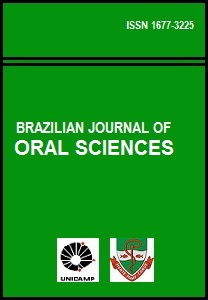Abstract
Metalloceramic restorations combine the aesthetic properties of ceramic materials with the high strength of metals. The titanium has excellent biocompatibility, good mechanical properties and low density, and has been recently used for metalloceramic prosthesis. The purpose of this study was to evaluate the shear bond strength of these two materials, and also analyze their bonding interface using Scanning Electron Microscopy (SEM). Thirty-six specimens were prepared and divided in three groups: Group 1- gold alloy (Degudent U-Degussa) + Vita Omega 900 ceramic(Vita) (control group); Group 2 – milled commercially pure titanium (cpTiDentaurum) + Titankeramik ceramic (Vita); Group 3 – cast and milled commercially pure titanium (cpTi-Dentaurum) + Titankeramik ceramic(Vita). The shear bond strength mechanical assay was performed in an Instron 4301 machine with capacity for 500Kg. After the test completion, surfaces were evaluated using SEM. The numerical results, put in tables, were: G1= 40,55MPa (+/- 4,8), G2= 63,54 MPA (+/- 1,73) and G3= 68,17 MPA (+/- 1,19). The statistical analysis (ANOVA) showed no significant statistically differences between groups G2 and G3 and the values were larger (significant statiscally) than G1. It is concluded that the titanium alloys is a good alternative to gold alloys to metalloceramic restorations emphasizing that it is cheaper, biocompatible and is has a low density.References
Persson M, Bergman M. Metal-ceramic bond strength. Acta Odontol Scand. 1996; 54: 160-5.
Mclean J W The metal-restoration. Dent Clin North Am. 1983; 27: 747-61.
Craig RG. Ceramic metal systems. In: Craig RG. Restorative dental materials. 9. ed. Sant Loouis: Mosby; 1993. Cap. 18, p.491-501.
Taira Y, Matsumura H, Yoshida K, Tanaka T, Atsuta M. Influence of surface oxidation of titanium on adhesion. J Dent. 1998; 26: 69-73.
Kononem M, Kivilathi J. Bonding of low-fusing dental porcelain to commercially pure titanium. J Biomed Mater Res. 1994; 28: 1027-35.
Hautaniemi JA, Hero H, Juhanoja JT. On the bonding of porcelain on titanium. J Mater Sci Mater Méd. 1992; 3: 180-91
Wang RR, Fung K K. Oxidation behavior of surface-modified titanium for titanium-ceramic restorations. J Prosthet Dent. 1997; 77: 423-34.
Vickery RC, Badinelli LA. Nature of attachment forces in porcelain-gold systems. J Dent Res. 1968; 47: 683-9.
Craig RG, Powers JM. Restorative dental materials. 11. ed. São Paulo: Santos; 2004. 704 p.
O´Brien W J. Dental materials. Properties and selection. Chicago: Quintessence Books; 1989. Cap. 21, p. 397-418.
Riley EJ. Ceramo-metal restorations. Dent Clin North Am. 1977; 21: 669-82.
Jesus Suarez M, Lozano JF, Paz Salido M, Martinez F. Marginal fit of titanium metal-ceramic crowns. Int J Prosthodont. 2005; 18: 390-1.
Oyafuso DK. Resistência ao cisalhamento entre titânio comercialmente puro e cerâmica [dissertação]. São José dos Campos: FOSJC/UNESP; 2001. 78f.
Hammad IA, Goodkind RJ, Gerberich WW. A shear test for the bond strength of ceramometals. J Prosthet Dent. 1987; 58: 431-7.
Kononem M, Kivilathi J. Fusing of dental ceramics to titanium. J Dent Res. 2001; 80: 848-54.
Gavelis JR, Lim SB, Guckes AD, Morency JD, Sozio RB. A comparison of the bond strength of two ceramometal systems. J Prosthet Dent. 1982; 48: 424-8.
Fonseca JC, Henriques GE, Sobrinho LC, de Goes MF. Stressrelieving and porcelain firing cycle influence on marginal fit of commercially pure titanium and titanium-aluminum- vanadium copings. Dent Mater. 2003; 19: 686-91.
Mackert JR Jr, Ringle RD, Parry EE, Evans AL, Fairhurst CW. The relationship between oxide adherence and porcelain-metal bonding. J Dent Res. 1988; 67: 474-8.
Dent RJ, Preston JD, Moffa JP, Caputo A. Effect of oxidation on ceramometal bond strength. J Prosthet Dent.1982; 47: 59-62.
Lautenschlager EP, Monaghan, P. Titanium and titanium alloys as dental materials. Int Dent J. 1993; 43: 245-53.
Van Vlack LH. Princípios de ciência dos materiais. São Paulo: Edgard Blucher; 1970. 427 p.
Malhotra ML, Maickel LB. Shear bond strength in porcelainmetal restorations. J Prosthet Dent. 1980; 43: 397-400.
Anusavice KJ. Phillip´s science of dental materials. 11. ed. Philadelphia: W.B. Saunder; 2004. 709p.
Drummond JL, Randolph RG, Jekkals VJ, Lenke JW. Shear testing of the porcelain-metal bond. J Dent Res. 1984; 63: 1400-1.
Lubovich RP, Goodkind RJ. Bond strength studies of precious, semiprecious, and nonprecious ceramic-metal alloys with two porcelains. J Prosthet Dent. 1977; 37: 288-99.
Chong MP, Beech DR A simple shear test to evaluate the bond strength of ceramic fused to metal. Aust Dent J. 1980; 25: 357-61.
Anusavice KJ, Dehoff, PH, Fairhurs CW. Comparative evaluation of ceramic-metal bond tests using finite element stress analysis. J Dent Res. 1980; 59: 608-13.
The Brazilian Journal of Oral Sciences uses the Creative Commons license (CC), thus preserving the integrity of the articles in an open access environment.

